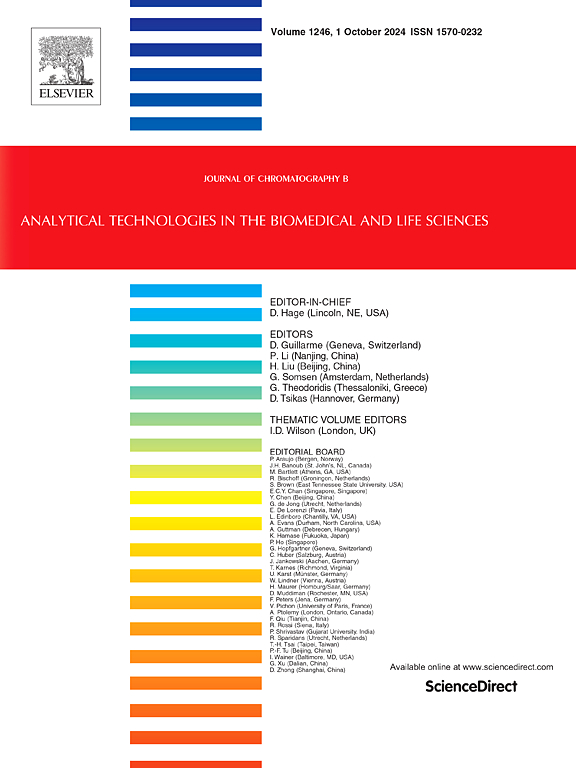Quantification of isavuconazole from dried blood spots: Applicability in therapeutic drug monitoring
IF 2.8
3区 医学
Q2 BIOCHEMICAL RESEARCH METHODS
引用次数: 0
Abstract
Dried blood spots (DBS) is a convenient method of blood sampling for biomedical quantification of various drugs. Compared to conventional venipuncture and subsequent plasma measurement, DBS provides advantages in less invasive sampling and easy and safe shipping of samples. The main drawback is the difficult calculation of precise plasma concentrations from the DBS measurements. In this study, a method for the quantification of the antimycotic drug isavuconazole from DBS was developed and its applicability in therapeutic drug monitoring (TDM) was evaluated by comparing the DBS quantification results with the corresponding plasma values.
DBS were produced by spotting 15 μL of EDTA-blood onto DBS cards. The whole DBS spots were extracted in methanol:water 10:1, and the extracts were analyzed by an established HPLC method using fluorescence detection. Isavuconazole proved to be stable in DBS over 3 weeks at room temperature or refrigerated at 6 °C. Intra-day precision and accuracies of the quantification from DBS were better than 5 %, while the inter-day results were better than 12 %.
Fourteen plasma samples from intensive care patients showing isavuconazole concentrations of <0.1 μg/mL to 3.52 μg/mL (median 1.42 μg/mL) were compared to the results obtained from corresponding DBS samples. All concentration values were covered by the calibration range (0.1–20 μg/mL) of the analytical method. Differences between plasma and DBS results were less than 0.2 μg/mL, with an underestimation of less than 6 % in the DBS values. As these differences were of no therapeutic relevance, DBS could be considered a viable matrix for TDM of isavuconazole in intensive care patients.
干血斑中异戊康唑的定量测定:在治疗药物监测中的适用性
干血点法是一种简便的生物医学定量方法。与传统的静脉穿刺和随后的血浆测量相比,DBS具有侵入性较小的采样和易于安全运输样品的优点。主要的缺点是很难从DBS测量中精确计算血浆浓度。本研究建立了一种DBS中抗真菌药物isavuconazole的定量方法,并将DBS定量结果与相应的血浆值进行比较,评价其在治疗药物监测(TDM)中的适用性。在DBS卡上滴注15 μL edta血产生DBS。用甲醇:水10:1提取整个DBS斑点,采用建立的高效液相色谱法进行荧光检测。Isavuconazole在室温或6°C冷藏条件下在DBS中稳定超过3周。DBS定量的日间精密度和准确度均优于5%,日间精密度和准确度均优于12%。将14例重症监护患者血浆样本中异唑康唑浓度为0.1 ~ 3.52 μg/mL(中位数为1.42 μg/mL),与相应DBS样本的结果进行比较。所有浓度均在分析方法的校准范围(0.1 ~ 20 μg/mL)内。血浆和DBS结果之间的差异小于0.2 μg/mL, DBS值低估小于6%。由于这些差异与治疗无关,DBS可以被认为是重症监护患者异戊康唑TDM的可行基质。
本文章由计算机程序翻译,如有差异,请以英文原文为准。
求助全文
约1分钟内获得全文
求助全文
来源期刊

Journal of Chromatography B
医学-分析化学
CiteScore
5.60
自引率
3.30%
发文量
306
审稿时长
44 days
期刊介绍:
The Journal of Chromatography B publishes papers on developments in separation science relevant to biology and biomedical research including both fundamental advances and applications. Analytical techniques which may be considered include the various facets of chromatography, electrophoresis and related methods, affinity and immunoaffinity-based methodologies, hyphenated and other multi-dimensional techniques, and microanalytical approaches. The journal also considers articles reporting developments in sample preparation, detection techniques including mass spectrometry, and data handling and analysis.
Developments related to preparative separations for the isolation and purification of components of biological systems may be published, including chromatographic and electrophoretic methods, affinity separations, field flow fractionation and other preparative approaches.
Applications to the analysis of biological systems and samples will be considered when the analytical science contains a significant element of novelty, e.g. a new approach to the separation of a compound, novel combination of analytical techniques, or significantly improved analytical performance.
 求助内容:
求助内容: 应助结果提醒方式:
应助结果提醒方式:


